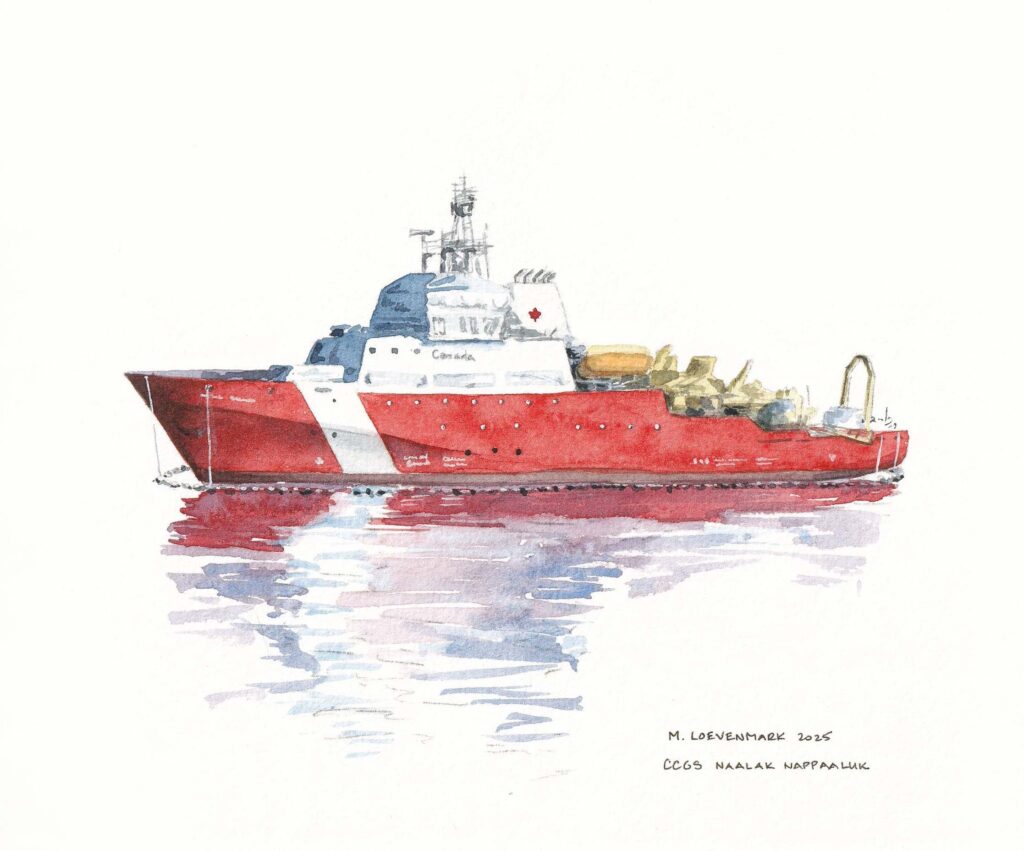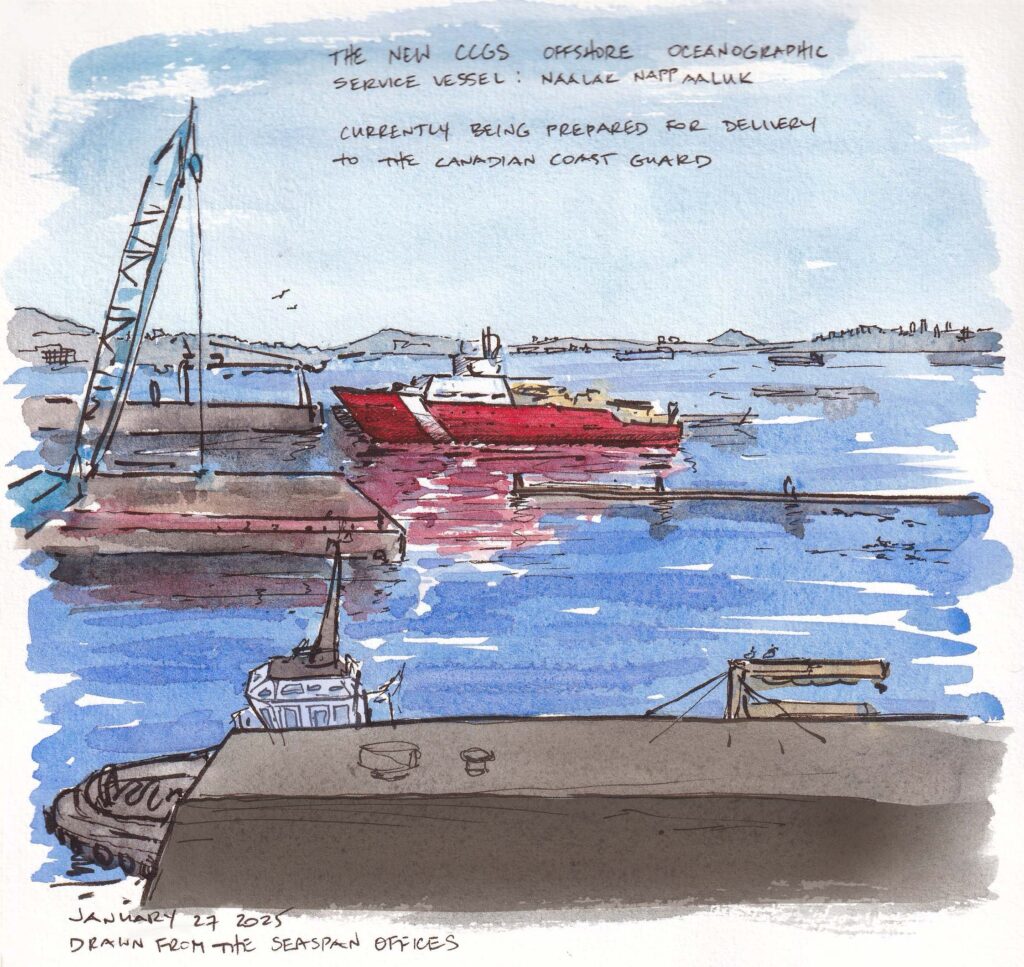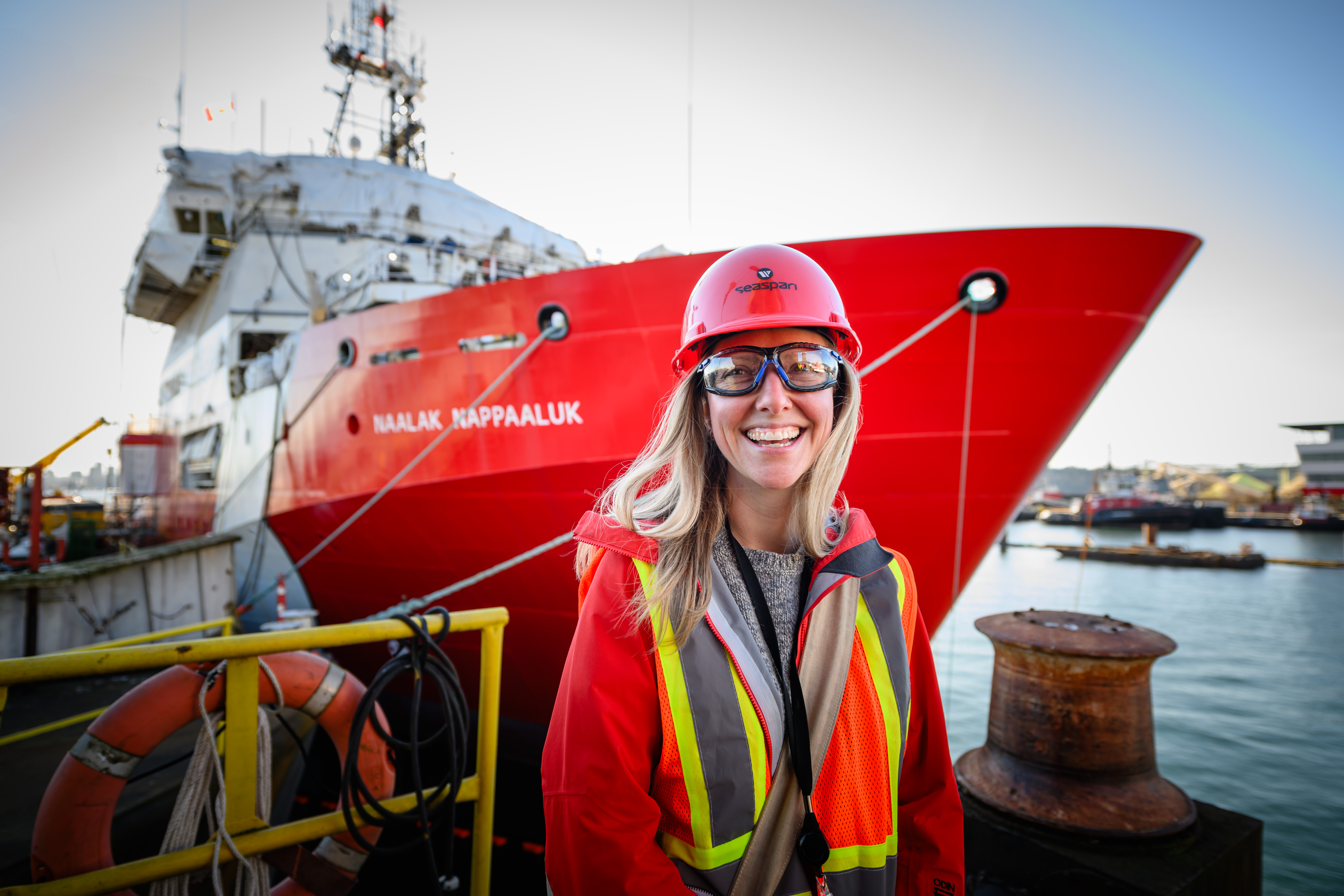February 19th, 2025
Running through North Vancouver, there is a lot to look at. From the view of the Vancouver skyline across the harbour, to the hustle and bustle of Lonsdale Quay — for something to catch your eye, it truly must stand out. For Monika Loevenmark, it was the sight of a bright red ship at Seaspan’s Vancouver Shipyard that caught her attention.
“It’s kind of remarkable that you’re in this little community of North Van, and then right there, in the heart of it, I see this incredible facility,” she said.
As a local artist, it’s part of Monika’s job to have a keen eye for anything that looks particularly visually distinct — but being drawn to Seaspan goes beyond casual interest. Ships are a part of who she is.
“I grew up on a boat and I saw them all the time, so I now just find them beautiful objects to look at,” she said.
So, it’s fitting that, in January, Monika would find her way back to a ship. Inspired by the sight of what was being made in the shipyard, she inquired about being able to come visit Seaspan and potentially paint some of the ships being built there, not expecting a response. Only a month later, she was onboard the CCGS Naalak Nappaaluk, sketchbook in hand.

“Shipbuilding is just fascinating to me,” she said. “What an incredible feat — but also, it’s these ships that allow for access to the most vulnerable places in the world when we’re talking about climate change.”
There’s a reason she highlights climate change. Growing up within arms-reach of the ocean has linked her inextricably to the natural environments she was raised in — environments that she is striving to preserve and protect. To do her part, she hopes that her artwork can spark a similar drive to protect the Earth’s natural wonder in those who view it.
“It’s just so important to me that I make work that would hopefully foster some kind of stewardship… if you can visualize these things in a really beautiful way, that brings them to light a bit more.”
Yet, while Monika may have a clear sense of purpose now, it wasn’t always that way. Before deciding to pursue the craft of fine art, her career took her in a very different direction.
“I actually tried really hard to be an architect, and then to work in land management, thinking that was one step closer to nature, and that would be the answer,” she said.
So, coming out of her schooling, Monika had a fairly unique pairing of degrees, with one in Fine Arts from Emily Carr University, and another from the University of British Columbia in Architecture and Environmental Design. However, even if architecture wasn’t her calling, the skills that she picked up during her time learning it has helped inform her unique artistic perspective.
By blending the often rigid, mathematics-focused world of architecture with the more free-flowing world of fine art, she has the ability to approach any task in the visual domain through a wide array of perspectives. This was potentially clearest in one of her most recent projects — an isometric diagram illustrating five methods of capturing salmon, commissioned by the University of California, Davis. There, Monika was pushed to draw from both sides of her experience.
“A scientific illustration is different from just a pretty picture in that it has to be technically and scientifically accurate. You’re talking to people who are the subject experts,” she said. “Your job is to make it pretty and communicate clearly, but their job is to say: ‘Oh, the bow of that ship doesn’t look exactly how I remember.’”
While reconciling those two seemingly disparate agendas may look to pose a challenge, to Monika, the worlds of science, mathematics and human-driven creation are inextricably connected to nature, and by association, art.
“It’s easy to find false binaries in our world, like, nature versus manmade construction,” she said. “But, really, it’s so connected. Everything is connected in terms of systems.”
By deconstructing this dichotomy, Monika’s artistic landscape is no longer confined to a hyper-specific niche. For her, making art about nature isn’t just about painting fish or the mountains, it can also be about something else — like a ship.
No vessel embodies that interconnectedness quite like an Offshore Oceanographic Science Vessel (OOSV), such as the CCGS Naalak Nappaluk. With onboard wet and dry labs, a system for studying oxygen levels in the water, and a sensor suite for collection and analysis of water-related data, the OOSV is uniquely positioned to further research on how climate change is impacting the health of Canada’s oceans, seabeds, and marine ecosystems.

In short, it sets out to enact the exact kind of natural conservation Monika seeks to inspire in her artwork.
So, in painting the OOSV, as Monika has, she is not departing from her passion for nature and conservation — instead acting to expand it. Because these vessels are a part of nature, not just through their direct interaction with it, but also in the integral research and conservation work they facilitate.
Eventually, when the OOSV is delivered to the Canadian Coast Guard and sets off on a new adventure— while there’s no telling exactly where it will go first — we can be certain that, piece by piece, it will be acting to improve the ecosystem in the Atlantic Ocean it will be operating in.
Fittingly, you could also say the same about Monika.
“What will satiate me and give me meaning and purpose in life will always be to create beauty that is about what is already here,” she said. “How can we conserve and steward what is already here? So, as long as I’m doing artwork… that is working to support the natural systems that don’t necessarily have a voice, in any capacity, I would be thrilled.”
